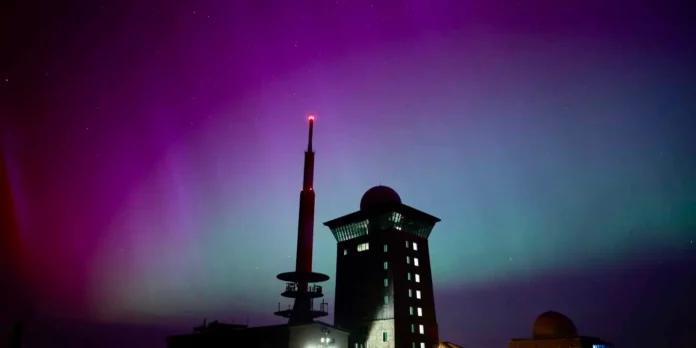
On Friday, May 10, Earth found itself under the throes of a cosmic spectacle as the most potent solar storm in over two decades swept across the planet.
The event, heralded by a cascade of coronal mass ejections (CMEs) from the Sun, not only painted the skies with mesmerizing auroras but also raised concerns about potential disruptions to vital systems, including satellites and power grids.
The US National Oceanic and Atmospheric Administration (NOAA) sounded the alarm, issuing a rare severe geomagnetic storm warning as the solar outburst arrived earlier than anticipated.
Initially categorized as severe, the storm swiftly escalated to an “extreme” level – a classification not witnessed since the infamous “Halloween Storms” of October 2003, which plunged parts of Sweden into darkness and wreaked havoc on South Africa’s power infrastructure.
A series of CMEs, heralded by the expulsion of plasma and magnetic fields from the Sun, set the stage for this celestial drama. These eruptions, traveling at an average speed of 800 kilometers per second, emanated from a colossal sunspot cluster spanning an expanse 17 times wider than Earth.
Such eruptions are characteristic of the Sun nearing the zenith of its 11-year activity cycle, a period marked by heightened solar activity.
Social media platforms became ablaze with breathtaking snapshots of auroras illuminating the skies over northern Europe and Australasia.
Photographer Sean O’Riordan captured the essence of the phenomenon, describing the skies over Tasmania as “absolutely biblical” in their splendor.
Authorities swiftly swung into action, notifying satellite operators, airlines, and power grid operators to brace for potential disruptions induced by the fluctuations in Earth’s magnetic field.
Airlines rerouted flights to mitigate the risk posed by increased radiation at higher altitudes, while power grid operators implemented precautionary measures to safeguard against blackouts.
Despite the looming threat, experts encouraged individuals to embrace the celestial spectacle. Professor Mathew Owens, a leading authority in space physics at the University of Reading, urged people to seize the opportunity to witness the auroras firsthand, especially those residing in the planet’s northern and southern latitudes.
He emphasized that the visibility of the auroras would hinge upon the final intensity of the storm. In the United States, regions such as Northern California and Alabama were identified as potential spots where the auroras might be visible.
NOAA’s Brent Gordon encouraged the public to capture the night sky using phone cameras, even if the auroras were not visible to the naked eye. Additionally, he advised those equipped with eclipse glasses to observe the sunspot cluster during daylight hours.
While the awe-inspiring display of auroras captivated onlookers, the underlying concern persisted regarding the potential ramifications of the solar storm’s impact on critical infrastructure.
As the solar storm persisted into the weekend and possibly beyond, the world remained vigilant, bracing for potential disruptions while marveling at the celestial grandeur unfurling above.
In the midst of this cosmic dance between Earth and the Sun, humanity found itself at once humbled by the forces of nature and inspired by the beauty of the cosmos, reminding us of our place in the vast expanse of the universe.
This article was created using automation and was thoroughly edited and fact-checked by one of our editorial staff members